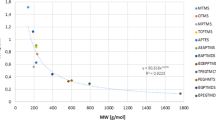Abstract
Wood was treated with a low molecular-weight silicic acid: boric acid agent and examined for increased resistance to termites and combustion. Wood treated with silicic acid only exhibited increased termite resistance, but not to the marked extent observed after treatment with a mixture of silicic and boric acids. Increasing the quantity of boric acid also increased the termite mortality rate and shortened the time to death. Oral-toxicity tests using dyed silicic acid: boric acid suggested that the boric acid in the agent acted as a stomach poison. Field tests on stakes over three years showed that even if stakes were placed near the termite exit, those treated with silicic acid and high levels of boric acid had no attack by termites and maintained their original form. Though these specimens were installed in the field during three rainy seasons (about six months in total) in three years, the termite resistance ability of these chemicals was maintained. It became clear that this silicic acid: boric acid agent has a high water resistance ability worthy of application in the outdoors. Combustion tests showed that flame and glowing combustion times were shortened at high levels of boric acid. When a boric acid: methanol solution was added at of rate of not less than 25 ml for 100 g of colloidal silicic acid solution (CSAS), flaming and glowing combustion were not observed. Although the charring length of the wood specimen which was treated with a low molecular weight silicic acid: boric acid agent decreased to 2/3 of that of the control wood, the charring lengths were not influenced by the level of boric acid. However, the volume of smoke decreased relative to the amount of boric acid that had been added.




Similar content being viewed by others
References
Barnes HM, Landers Jr RW, Williams LH (1993) Thermal treatment of southern pine timbers with borates. Forest Prod J 43(3):31–34
Choi JM, Pak CH, Lee CW (1996) Micronutrient toxicity in French marigold. J Plant Nutr 19(6):901–916
Drahota Z, Vrbacky M, Rauchova H, Kalous M (1996) Inhibition of mitochondrial cytochrome c oxidase by dicarbanonaborates. Biochem Mol Biol Int pp 1267–1273
Grace JK, Yamamoto RT, Tamashiro M (1992) Resistance of borate-treated Douglas-fir to the Formosan subterranean termite. Forest Prod J 42(2):61–65
Morrell JJ, Sexton CM, Preston AF (1990) Effect of moisture content of Douglas-fir heartwood on longitudinal diffusion of boron from fused borate rods. Forest Prod J 40(4):37–40
Nishimoto K (1982) Toxicity of wood preservatives. Mokuzai Hozongaku (Wood preservative science), Bunkyou-syuppan, p181
Nishimoto K (1992a) Mokuzai boucyuzai (Insecticide for wood). Mokuzai Hozongaku Nyumon (Handbook of wood preservative science), Japan Wood Preserving Association (JWPA), p116
Nishimoto K (1992b) Mokuzai boukazai (Fire-retarding agent for wood). Mokuzai Hozongaku Nyumonn (Handbook of wood preservative science), Japan Wood Preserving Association (JWPA), p128–129
Thevenon M-F, Pizzi A, Haluk J-P (1998) Protein borates as non-toxic, long-term, wide-spectrum, ground-contact wood preservatives. Holzforschung 52(3):241–248
Ueda S (1993) Jikken kagaku kouza (Text of experimental chemistry, 4th edn). Maruzen (16):588
Williams LH, Mauldin JK (1986) Integrated protection agent lyctid beetle infestations III. implementing boron treatment of Virola timber in Brazil. Forest Prod J 36(11–12):24–28
Williams LH, Parresol BR (1991) Borate diffusion into red oak sapwood lumber: an initial assessment. Forest Prod J 41(5):45–48
Yamaguchi H (1994a) Preparation and physical properties of wood fixed with silicic acid compounds. Mokuzai Gakkaishi 40(8):838–845
Yamaguchi H (1994b) Properties of silicic acid compounds as chemical agents for impregnation and fixation of wood. Mokuzai Gakkaishi 40(8):830–837
Yamaguchi H (2001) Low molecular weight silicic acid—inorganic compound complex as wood preservative. Wood Sci Technol (in press)
Yamaguchi H, Östman BA-L (1996) Complexes of silicic acid polymer—inorganic compounds as wood preserving agents. Mokuzai Hozon (Wood Preservation) 22(5):254–261
Author information
Authors and Affiliations
Corresponding author
Rights and permissions
About this article
Cite this article
Yamaguchi, H. Silicic acid: boric acid complexes as wood preservatives. Wood Sci Technol 37, 287–297 (2003). https://doi.org/10.1007/s00226-003-0190-8
Received:
Published:
Issue Date:
DOI: https://doi.org/10.1007/s00226-003-0190-8




